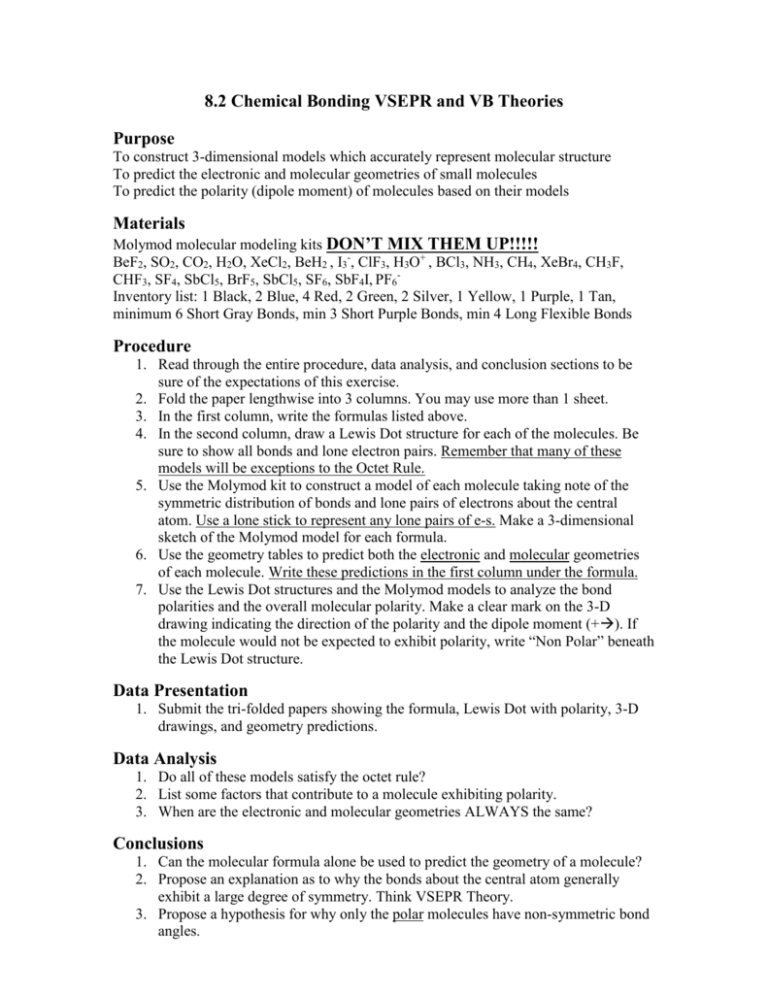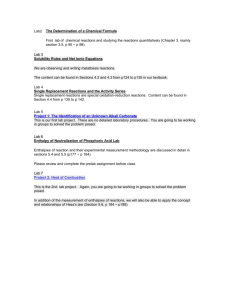Bonding Lab 8.2
advertisement

8.2 Chemical Bonding VSEPR and VB Theories Purpose To construct 3-dimensional models which accurately represent molecular structure To predict the electronic and molecular geometries of small molecules To predict the polarity (dipole moment) of molecules based on their models Materials Molymod molecular modeling kits DON’T MIX THEM UP!!!!! BeF2, SO2, CO2, H2O, XeCl2, BeH2 , I3-, ClF3, H3O+ , BCl3, NH3, CH4, XeBr4, CH3F, CHF3, SF4, SbCl5, BrF5, SbCl5, SF6, SbF4I, PF6Inventory list: 1 Black, 2 Blue, 4 Red, 2 Green, 2 Silver, 1 Yellow, 1 Purple, 1 Tan, minimum 6 Short Gray Bonds, min 3 Short Purple Bonds, min 4 Long Flexible Bonds Procedure 1. Read through the entire procedure, data analysis, and conclusion sections to be sure of the expectations of this exercise. 2. Fold the paper lengthwise into 3 columns. You may use more than 1 sheet. 3. In the first column, write the formulas listed above. 4. In the second column, draw a Lewis Dot structure for each of the molecules. Be sure to show all bonds and lone electron pairs. Remember that many of these models will be exceptions to the Octet Rule. 5. Use the Molymod kit to construct a model of each molecule taking note of the symmetric distribution of bonds and lone pairs of electrons about the central atom. Use a lone stick to represent any lone pairs of e-s. Make a 3-dimensional sketch of the Molymod model for each formula. 6. Use the geometry tables to predict both the electronic and molecular geometries of each molecule. Write these predictions in the first column under the formula. 7. Use the Lewis Dot structures and the Molymod models to analyze the bond polarities and the overall molecular polarity. Make a clear mark on the 3-D drawing indicating the direction of the polarity and the dipole moment (+). If the molecule would not be expected to exhibit polarity, write “Non Polar” beneath the Lewis Dot structure. Data Presentation 1. Submit the tri-folded papers showing the formula, Lewis Dot with polarity, 3-D drawings, and geometry predictions. Data Analysis 1. Do all of these models satisfy the octet rule? 2. List some factors that contribute to a molecule exhibiting polarity. 3. When are the electronic and molecular geometries ALWAYS the same? Conclusions 1. Can the molecular formula alone be used to predict the geometry of a molecule? 2. Propose an explanation as to why the bonds about the central atom generally exhibit a large degree of symmetry. Think VSEPR Theory. 3. Propose a hypothesis for why only the polar molecules have non-symmetric bond angles.





